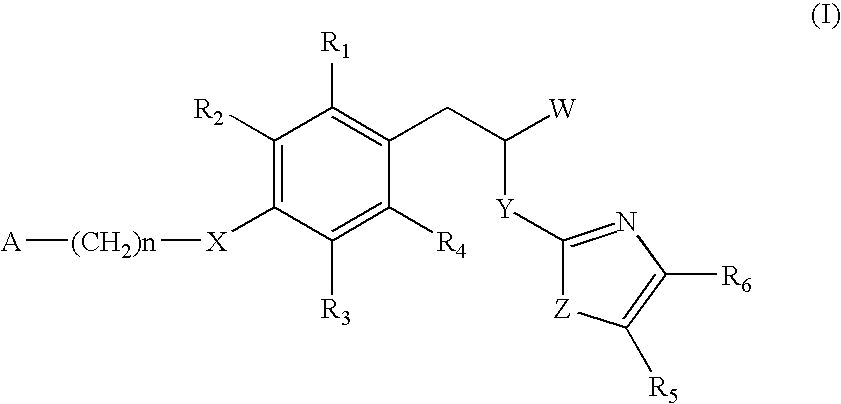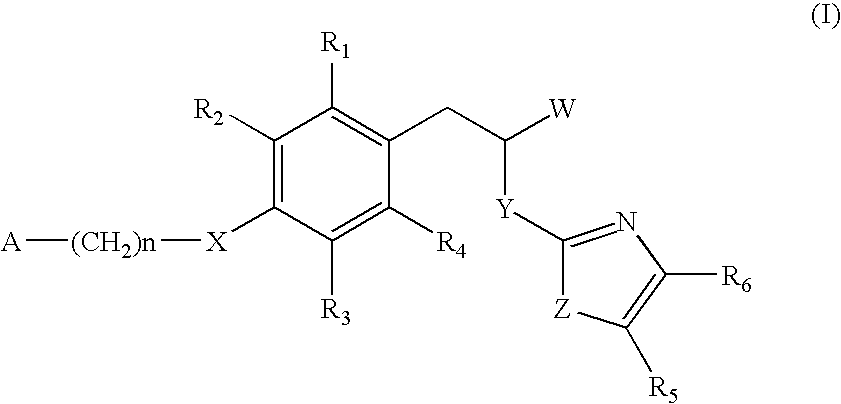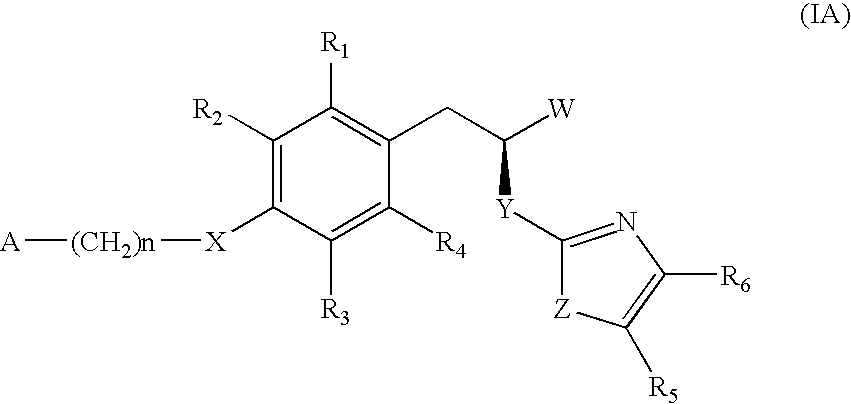3-Phenylpropionic acid derivatives
a technology of phenylpropionic acid and derivatives, applied in the field of new compounds, can solve the problems of increased risk of blindness, renal insufficiency and neuropathy, and achieve the effects of reducing the risk of blindness, and improving the safety of us
- Summary
- Abstract
- Description
- Claims
- Application Information
AI Technical Summary
Benefits of technology
Problems solved by technology
Method used
Image
Examples
example 1
(2S)-3-{4-[(3,5-Dimethylisoxazol-4-yl)methoxy]phenyl}-2-[(4-phenyl-1,3-thiazol-2-yl)amino]propionic acid and its methyl ester
[0105] R1 to R5═H, R6═C6H5, W═COOH / COOCH3, X═O, Z=S, Y═NH, n=1, A=3,5-dimethylisoxazol-4-yl
Step A: methyl(2S)-3-(4-hydroxyphenyl)-2-[(4-phenyl-1,3-thiazol-2-yl)amino]propionate
[0106] 15.40 g (0.1 mol) of phenacyl chloride and 8.66 g (0.107 mol) of dry sodium thiocyanate in ethanol (200 ml) were stirred for 3 h at 50° C. The solution of 19.51 g (0.1 mol) of (S)-tyrosine methyl ester in ethanol (100 ml) was added in one portion and the reaction mixture was stirred for 12 h. After removing ethanol by distillation, water and ethyl acetate were added. Aqueous phase was extracted twice with ethyl acetate, combined organic phases were dried over sodium sulfate, and the solvent was evaporated. The product was purified by chromatography. The yield was 20.54 g (58%). MS (ES) 354 (M+, 100%)
Step B: Methyl(2S)-3-{4-[(3,5-dimethylisoxazol-4-yl)methoxy]phenyl}-2-[(4-phen...
example 2
(2S)-3-(4-{2-[(Cyclohexylcarbonyl)(methyl)amino]ethoxy}phenyl)-2-[(4-phenyl-1,3-thiazol-2-yl)amino]propionic acid and its methyl ester
[0109] R1 to R5═H, R6═C6H5, W═COOH / COOCH3, Y═NH, X═O, Z=S, n=1, A=(cyclohexylcarbonyl)(methyl)amino of the formula:
Step A: Methyl(2S)-3-{4-[(methylsulfonyl)amino]phenyl}-2-[(4-phenyl-1,3-thiazol-2-yl)amino]propionate
[0110] 29.1 g (0.1 mol) of N-[4-(2-bromoacetyl)phenyl]methanesulfonamide and 8.66 g (0.107 mol) of dry sodium thiocyanate in ethanol (200 ml) were stirred for 3 h at 50° C. The solution of 19.51 g (0.1 mol) of (S)-tyrosine methyl ester in ethanol (100 ml) was added in one portion and the reaction mixture was stirred for 12 h. After removing ethanol by distillation, water and ethyl acetate were added. Aqueous phase was then extracted twice with ethyl acetate, combined organic phases were dried over sodium sulfate and the solvent was evaporated. The product was purified by chromatography (SiO2, ethyl acetate / hexane). The yield was 20.12 ...
example 3
(2S)-3-(4-{2-[(Cyclohexylcarbonyl)(methyl)amino]ethoxy}phenyl)-2-[4-(4-cyanophenyl-1,3-thiazol-2-yl)amino]propionic acid and its methyl ester
[0114] R1 to R5═H, R6=4-CN—C6H5, W═COOH / COOCH3, X═O, Z=S, Y═NH, n=2, A=(cyclohexylcarbonyl)(methyl)amino of the formula:
Step A: Methyl(2S)-2-{[4-(4-cyanophenyl)-1,3-thiazol-2-yl]amino}-3-(4-hydroxyphenyl)propionate
[0115] 22.3 g (0.1 mol) of 4-(bromoacetyl)benzonitrile and 8.66 g (0.107 mol) of dry sodium thiocyanate in ethanol (200 ml) were stirred for 3 h at 50° C. Then 19.51 g (0.1 mol) of (S)-tyrosine methyl ester in ethanol (100 ml) was added in one portion and the reaction mixture was stirred for 12 h. After removing ethanol by distillation, water and ethyl acetate were added. Aqueous phase was extracted twice with ethyl acetate, combined organic phases were dried over sodium sulfate and the solvent was evaporated. The product was purified by chromatography (SiO2, ethyl acetate / hexane). The yield was 53%. MS (ES) 379 (M+, 100%)
Step B:...
PUM
| Property | Measurement | Unit |
|---|---|---|
| Composition | aaaaa | aaaaa |
| Configuration | aaaaa | aaaaa |
Abstract
Description
Claims
Application Information
 Login to View More
Login to View More - R&D
- Intellectual Property
- Life Sciences
- Materials
- Tech Scout
- Unparalleled Data Quality
- Higher Quality Content
- 60% Fewer Hallucinations
Browse by: Latest US Patents, China's latest patents, Technical Efficacy Thesaurus, Application Domain, Technology Topic, Popular Technical Reports.
© 2025 PatSnap. All rights reserved.Legal|Privacy policy|Modern Slavery Act Transparency Statement|Sitemap|About US| Contact US: help@patsnap.com



